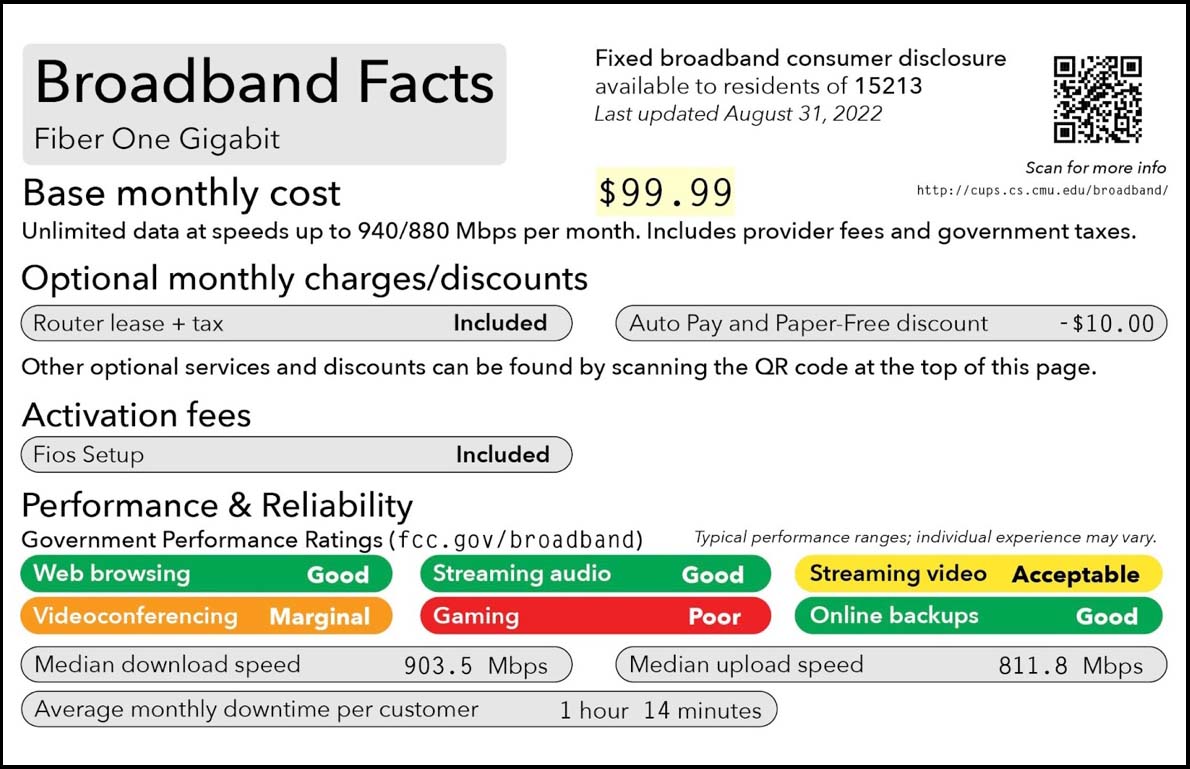
CyLab proposes improved, consumer-friendly broadband “nutrition” labels
By Ryan Noone
For nearly 20 years, researchers at Carnegie Mellon CyLab Security and Privacy Institute have been advocating for consumers, leading the charge by gathering insights and developing tools to better inform users about the technology they utilize and bring into their homes. From finding innovative ways to convey privacy information to users visiting websites or using mobile apps, to creating security disclosures for IoT devices, CyLab has answered the call.
So, it's no surprise that Lorrie Cranor, CyLab Director and professor in CMU's Software and Societal Systems (S3D) and Engineering and Public Policy (EPP) departments, was invited to speak at an April 2022 Federal Communications Commission virtual public hearing on broadband consumer labels. The FCC issued a Notice of Proposed Rulemaking (NPRM) in January 2022 to move forward with a proposal that would require broadband internet providers to display easy-to-understand labels, enabling consumers to comparison shop for broadband services.
“We have a long history of doing privacy research that involves consumers,” said Cranor. “So, when the FCC staff asked me to comment on what would make broadband internet labels useful, I told them that it was important to survey consumers to find out.”
The FCC has been tinkering with the idea of broadband labels since 2009. In 2016, it created templates for broadband providers to use. The industry, however, was hesitant to adopt the new labels, and without legislation, the initiative fell by the wayside. However, the Infrastructure Investment and Jobs Act now requires the FCC to mandate that providers create consumer-friendly labels with information about their broadband services.
In response to the FCC's request for comment, CyLab conducted a large-scale user study of more than 2,500 participants, uncovering the information most important to consumers shopping for broadband internet service and determining what terminology and presentation formats make this information most understandable and useful.
In the first phase of the study, experts Cranor, Jon Peha, a professor in EPP who served as the FCC’s Chief Technologist back when broadband labels were first proposed, and Christopher Choy, a master's student in S3D, led a team that examined the FCC's proposed 2016 broadband consumer labels to determine what information users found helpful and what was confusing.
Findings revealed participants strongly supported the idea of broadband labels and showed consumers were most concerned with cost, speed, and reliability when making purchasing decisions. Participants were also interested in measures of performance other than just downstream speed. Moreover, they cared about broadband performance during periods when performance is normal and much worse than normal, rather than under the best possible conditions as one typically sees in today’s advertisements. Consumers said they struggled to compute total service cost over a several-year span using the FCC's version of the labels and expressed a lack of knowledge of many technical terms used.
With these insights, CyLab's researchers went to work, developing and proposing their own set of broadband labels. Students Ellie Young and Megan Li iterated on label design, compiling the information consumers were most interested in, clearly and concisely, in a tabular format.
Next, the team surveyed participants to compare the effectiveness of their new label design with the FCC's 2016 labels.
Overall, CyLab's proposed labels performed better than the FCC's. Consumers appreciated having access to more detailed information and found the new labels easier to use and comprehend.
During the comparison, participants further expressed their desire to know the total cost of their internet plan without any ambiguity and were happy with the way CyLab's labels incorporate taxes, fees, and optional monthly charges and discounts. Results also revealed that consumers are interested in knowing how much the listed performance metrics could drop during peak times, along with explanations for any technical terms.
The CyLab researchers made further improvements to their label designs based on their survey results, introducing a layered design with a summary and full version to help address the needs of a wider range of consumers.
“Broadband labels should balance the needs of consumers who value simplicity and conciseness with those who value detailed information,” explained Choy.
CyLab’s researchers also believe the FCC should require broadband service providers to deposit detailed plan information in a standardized computer-readable form. They say this information should be housed in a publicly accessible database, enabling third parties to generate customized labels for consumers, and offer comparison shopping tools, quality of experience or suitability ratings, and other value-added services.
“We would love to see a website where consumers enter their zip code, some information about the number of people in their household, and the types of internet services they use, and in turn get a plan comparison tailored to their needs,” said Cranor. “A database of broadband label information would help make that happen.”
The researchers hope their proposed label designs and research report will help the FCC staff better account for consumer needs and preferences as they draft broadband label requirements.
To learn more about CyLab’s broadband internet consumer disclosure label research, visit https://cups.cs.cmu.edu/broadband/.